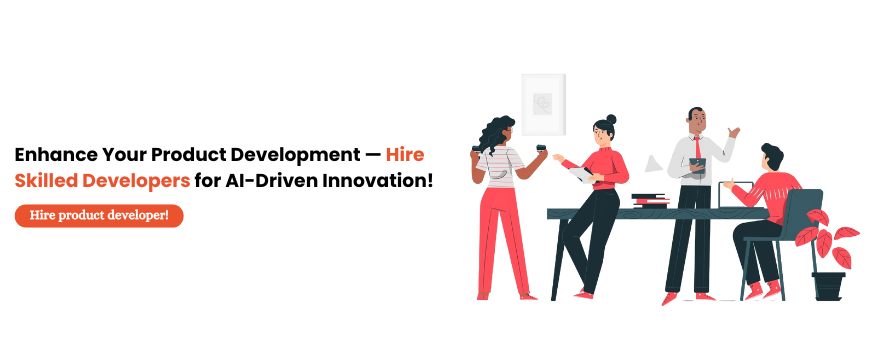
Collaborative AI for Cross-Functional Teams: Integrating AI into Product Development Workflows

The new fast-track corporate world calls for innovation and success through the ability of various teams to collaborate effectively. However, because of disparities in goals, communication preferences, and areas of competence, promoting smooth cross-functional collaboration can be difficult.
Artificial Intelligence (AI) is becoming a potent technology for closing these gaps, improving teamwork, and producing superior results. This article explores how artificial intelligence is changing cross-functional cooperation and provides tips for using AI to boost productivity and teamwork.
Stages of Incorporating AI into Product Development
The different stages of incorporating AI into product development are mentioned below:-
- Begin With Market Analysis
A good understanding of the market is essential before choosing an AI-integrated solution. The process starts with serious market research, which discovers new concepts about the product to be developed in ways that differentiate it from other companies and respond to unexpected consumer needs.
To understand your domain effectively, you can use the SWOT (Strengths, Weaknesses, Opportunities, and Threats) model. This will help you generate innovative ideas for products that meet customer needs.
- Find the Right AI Development Team
You need to build a team that will navigate the complex landscape of integrating AI. Evaluate your current resources and future needs and see if your team possesses the skills to implement sophisticated AI workflows. Consider near-shore or offshore outsourcing if you feel like there is a talent gap in your team.
- Outsource the Necessary AI Tools
You would have several options when making an outsourcing decision, but freelancers tend to be more free. However, when you are handling more than one project simultaneously, you will require a rich reservoir of meticulously vetted talent. This is where AI Talent Cloud solutions can help, as they have a pre-vetted pool of professionals excelling across a wide range of domains. Using the AI algorithm, the platform provides a list of 5 high-quality talents that meet the job description, and you can close the vacancy within 2-3 days.
- Considering the Integration of AI in the Development Stage
Once you have the team and AI tools, the team can start working on deciding where to apply artificial intelligence in the product development stages. This depends on a sharp understanding of the needs peculiar to your product and intended market. From designing to testing and marketing, AI tools can be implemented throughout the product development lifecycle to streamline the entire process and facilitate quicker releases.
Different Ways to Implement AI in Product Development
Product development processes may be made simpler, innovation could be encouraged, and productivity could rise significantly with AI process integration. The following are some areas where AI can be incorporated into product development processes:
1. Personalization
Artificial intelligence makes use of user data to target certain individuals. There are AI-driven recommendation engines that can be integrated into eCommerce or digital platforms to provide tailored recommendations to users based on their historical data and browsing behavior. There are different approaches, like collaborative filtering, content-based filtering, and hybrid filtering, that a recommendation engine can be based upon to suggest tailored recommendations.
2. Market Research and Analysis
AI systems can analyze voluminous data quickly and efficiently. With all the different types of data available from social media, surveys, and current industry statistics, it is easy to identify gaps in the market quickly. Analyzing qualitative data often takes hours. Under other circumstances, these hours could be spent more intelligently and differently.
3. Quality Control and Testing
The process of developing software products requires code testing, also known as QA software and testing services, to ensure that the final product satisfies industry requirements and accepted standards. With AI-based code testing approaches using prompt engineering, code evaluation, and problem detection, including coding flaw correction, could be done automatically.
It produces faster and more effective testing procedures than manual testing, which entails developers and testers manually identifying and resolving bugs.
4. Competitive Analysis
With AI systems, you can eliminate the tedious and manual efforts of tracking competitor strategies, as these systems can perform competitor analysis for you and provide you with insights. Advanced AI prompting techniques, like Chain of Thought prompting, prompt engineering, iterative refinement, Socratic questioning, and zero-shot learning, can help in finding the appropriate information about your competitors through Generative AI.
Tips to Effectively Manage Collaborative AI For Teams
AI can be used to facilitate cross-team communication, and there are several advantages to integrating AI into your cross-functional processes. Planning is necessary for the appropriate strategy, nevertheless, as it is for any plan involving the adoption of new technology in the workplace. Here are some best practices for integrating AI into cross-team work effectively.
- Select the Right AI Solutions
Investing in the appropriate tools and applications is the first step towards ensuring AI can be used in communication tools for remote teams. Your employees’ current software and tools should be compatible with all AI solutions designed for cross-functional teams. Selecting a highly adaptable AI system that works with a variety of productivity and project management apps, like Google Gemini or Microsoft Copilot, will speed up usage.
- Evaluate, Monitor, and Optimize
Track how your AI solutions are supporting your collaborative efforts, just like you would any new tool’s influence on your organization. Keep an eye on measures like engagement levels and deadline adherence that show effective cross-team collaboration. Request feedback from your team regarding their use of AI tools. Make sure that if they experience any problems with AI translation or meeting summary tools, they may report errors and make requests.
- Teach Teams to Use AI to Collaborate Across Teams
Ensure that your staff members are proficient in using AI solutions for inter-team cooperation. Give teams access to training materials, webinars, training films, and courses that demonstrate how to use various AI technologies efficiently. Discuss best practices for using AI in meetings, brainstorming sessions, and design projects, among other cross-team cooperation activities.
The Bottom Line
When combined, AI shortens time-to-market through intelligent automation and data-driven insights. It also enhances teamwork and encourages creativity—two important advantages. This particularly applies to the creation of new products. However, its advantages go beyond development. It might facilitate the hiring process acceleration.
AI is useful for application screening. Analyzing skills and projecting performance aids in quicker and better-informed decision-making. Hyqoo’s AI-powered Talent Cloud platform simplifies difficult tasks so that your team may concentrate on innovation and strategic planning. Visit Hyqoo to hire the right technology experts to enhance AI collaboration within your cross-functional teams.


FAQs
- How to ensure the successful adoption of AI for cross-team collaboration?
Providing training sessions and demonstrating the successful use of AI while collaborating with teams can help build team members’ confidence in the AI tool adopted. Take regular feedback from the teams to enhance the model to ensure your requirements are being met.
- Can AI assist in managing remote teams?
Yes! AI can help in managing schedules, tracking project progress and overall quality of the work submitted by remote team members.
- What are the potential challenges with integrating AI in product development workflows?
Resistance to change by team members, data privacy, and lack of training among team members can be potential issues a company can face while integrating AI into workflow.































































































































































































































































































































































































































































































































































































































































































































































